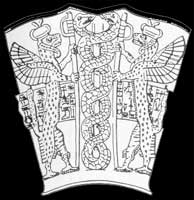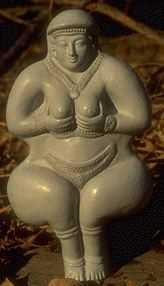Son RiseThe first king of Eridu ruled for 28,800 years, at least according to all the Sumerian king lists. The ages of the Biblical Patriarchs can defy imagination, but the ancient kings of Sumer had reigns that were truly cosmic. The king lists have been found at different times in different places, but the first fragment was discovered in Enlil's temple library in Nippur in the early 1900s. The most complete copy was bought in the antiquities market after the first World War and is now housed in an Oxford museum in England.  Ur, 3500 B.C. The king list actually has two listings of Dumuzi on the lists. The second one, called 'the fisherman' is one of the first kings of Uruk. Dumuzi is also the husband of the love goddess Inanna (daughter of the moon god Nanna). The title most associated with the deity Dumuzi is 'the shepherd', suggesting that he was the king of Bad-Tibira. But in the text Inanna's Descent to the Netherworld, it is Uruk that Dumuzi is ruling over. Dumuzi the Fisherman was also the first king to enact the Sacred Marriage Rite.5 According to The Courtship of Dumuzi and Inanna, Dumuzi was the offspring of Enki and Sirtur. He is also linked to the god of the dawn Ningishzida ("Lord-Productive-Tree"). In Babylonian literature Dumuzi and Gizzida (Ningishzida) are guardians of Anu's heavenly gates. Engraving of Inanna It is written in Sumerian texts that Inanna's name is derived from Nin-anna ("Lady of Heaven"), but it also seems that the name is at least partially derived from her father. She is the first in a long line of love goddess incarnations that spread throughout the Near East and Western world. Her Semitic (Akkadian) name was Ishtar, the whore of Babylon. She was Aphrodite to the Greeks and Venus to the Romans. In the Old Testament she's referred to as Ashtoreth ("Lady of Shame"), which was a derivation of her Canaanite name Asherah. Inscriptions from archaeological finds have shown that Asherah was popularly worshipped as the consort of Yahweh in both Israel and Judah.10 In contrast, the Old Testament refers to the state of Israel as Yahweh's bride. Asherah's symbol of fertility was the upright pole, representing the Tree of Life. Two of the more appreciated kings of Judah in the 700s B.C., Chizki-Yahu (Hezekiah) and Yoshi-Yahu (Josiah), went on campaigns to rid the land of all of these "Asherah poles" (2 Kings 18:4, 23:15). However, the poles lived on in Greek art and later became the symbol of Hermes. Snakes, representing the male anatomy, were depicted mating while wrapped around the tree. Today the Asherah pole is illustrated in the caduceus on every ambulance and hospital in the western world.  Copulation coin with snake The Asherah pole's depiction is generally believed to have come form the ancient Mesopotamian treatment for Draconculiasis ("Little Dragon" of Medina), a parasitic guinea worm that comes from drinking water contaminated with cyclops crustaceans. These creatures carry the larva of the guinea worm, which once born, kills the cyclops and burrows into the intestinal wall. The male worms die shortly after mating in the abdominal cavity. The females, which can grow to be a meter long, go on a long journey to the foot, where they secrete a substance that causes inflammation so that when scratched and doused with water, the worm can spit it's larvae into a new water source. The way to treat is it to wrap it around a stick daily so that it will be tight enough to slowly pull out.11 Many people believe Draconculiasis were the "fiery serpents" that the Hebrews were afflicted with during the exodus from Egypt: "They traveled from Mount Hor by the way to the Sea of Reeds, to compass the land of Edom: and the soul of the people was much discouraged because of the way. The people spoke against Elohim, and against Moshe [Moses], "Why have you brought us up out of Egypt to die in the wilderness? For there is no bread, and there is no water; and our soul loathes this light bread. Yahweh sent fiery serpents among the people, and they bit the people; and much people of Yisra-El [Israel] died. The people came to Moshe, and said, We have sinned, because we have spoken against Yahweh, and against you; pray to Yahweh, that he take away the serpents from us. Moshe prayed for the people. Yahweh said to Moshe, Make you a fiery serpent, and set it on a pole: and it shall happen, that everyone who is bitten, when he sees it, shall live. Moshe made a serpent of brass, and set it on a pole: and it happened, that if a serpent had bitten any man, when he looked to the serpent of brass, he lived." -Numbers 21:4-8
The caduceus remained in the community a religious artifact for about 570 years, and then:
"Now it happened in the third year of Hoshea, son of Elah, king of Yisra-El, that Chizki-Yahu [Hezekiah], the son of Achaz, king of Yehudah [Judah], began to reign. He was 25 years old when he began to reign; and he reigned 29 years in Yerushalayim [Jerusalem]: and his mother's name was Avi the daughter of Zekhar-Yah [Zechariah]. He did that which was right in the eyes of Yahweh, according to all that David his father had done. He removed the high places, and broke the pillars, and cut down the Asherah: and he broke in pieces the brazen serpent that Moshe had made; for to those days the children of Yisra-El did burn incense to it; and he called it Nechushtan." -2 Kings 18:1-4 Necushtan sounds like the Hebrew for 'bronze', 'snake' and 'unclean thing'. It is mentioned again in the Gospel of John: "Just as Moses lifted up the snake in the desert, so the Son of Man must be lifted up, that everyone believes in him may have eternal life." -John 3:14-15
In The Courtship of Dumuzi and Inanna, Inanna's brother Utu, the sun god, arranged for her to marry Dumuzi. But Inanna was not overjoyed at the idea of marrying the shepherd since she was in love with the farmer and she complained about the roughness of Dumuzi's clothing to her brother. Utu tells Inanna that Dumuzi will be a good provider but she insults Dumuzi, telling the shepherd that without her parents and siblings he would have no roof over his head and would be driven away. Dumuzi is more calm and asks Inanna not to quarrel, but ensures her that his parents are just as good as her parents. He then asks to talk the situation over:
"The words they had spoken was a word of desire. Just like in Moonlighting. Dumuzi then went to the royal house with milk and cream and asked Inanna to open the door for him. Inanna asked her mother Ningal, who told her that Dumuzi was now to be her father and mother. In another version of The Courtship, Inanna tricks her mother and the two elopers make love under the moon while her mother thinks she is at the square with a girlfriend.5 "What I tell you let the singer weave into song. What I tell you, let it flow from ear to mouth, let it pass from old to young: my vulva, the horn, the Boat of Heaven, is full of eagerness like the young moon. My untilled land lies fallow. As for me, Inanna, Who will plow my vulva? Who will plow my high field? Who will plow my wet ground? As for me, the young woman, Who will plow my vulva? Who will station the ox there? Who will plow my vulva?" Dumuzi chivalrously suggests himself as a candidate for the task to which Inanna heartily replies: "Then plow my vulva, man of my heart! Plow my vulva!" At the king's lap stood the rising cedar. Plants grew high by their side. Grains grew high by their side. Gardens flourished luxuriantly.
Inanna's servant Ninshubur led Dumuzi to "the sweet thighs of Inanna" and asks that Dumuzi's shepherd staff of judgment protect both Sumer and Akkad, from the land of the haluppu tree (Uruk) to the land of the cedar (Lebanon). Dumuzi took Inanna to the sacred bridal bed and tounge-played "one-by-one" fifty times. Dumuzi then asked Inanna that she set him free, assuring her that she would be like a daughter onto his father. Inanna gives a fair adieu to her lover, ending the poem with Inanna describing the sweet allure of her holy statue Dumuzi. The Courtship texts have much in common with the Hebrew Song of Solomon, also called the Shir Hashirim ("Song of Songs"), the Canticle of Canticles, or the Book of Wisdom. This Old Testament book is said to have been written by King Schlomo (Solomon) for a Shulamite maiden around 965 BC. The Song of Solomon is one of the five scrolls of Megilloth, which are read during Jewish feasts and is believed by some to be an allegory about God's love for Israel. Just like in the Courtship of Dumuzi and Inanna, the husband is called a king and a shepherd, while his bride is also referred to as his sister: "How fair is thy love, my sister, my spouse! How much better is thy love than wine, and the fragrance of your ointments than any spice! Your lips, oh my spouse, drop as the honeycomb: milk and honey are under your tongue. The smell of your garments is like the smell of Lebanon. You are a garden locked up, my sister, my spouse, a spring enclosed, a fountain sealed." The style, theme and a good deal of content of the texts are identical. Both canticles consist largely of lovers' dialogues separated by musical refrains, both use the terms milk and honey as sexual euphemisms, and both move from the mother's house to a special apple tree for the honeymoon: "If only you were to me like a brother, who sucked the breasts of my mother! If I found you outside, I would kiss you; yes, and no one would despise me. I would lead you, bringing you into my mother's house, who would instruct me. I would have you drink spiced wine, the nectar of my pomegranate. His left hand should be under my head, and his right hand should embrace me. I charge you, oh daughters of Jerusalem, that you should not arouse nor awaken love until it so desires. "Who is this who comes up from the wilderness, leaning on her lover? Under the apple tree I roused you; there your mother conceived you; there she was in labor and bore you. Set me as a seal upon your heart, as a seal upon your arm, for love is as strong as death; jealousy as cruel as She'ol [the netherworld]; It's flashes are flashes of fire, like a mighty flame of Yah[weh]. " -Song of Solomon 8:1-6 These kinds of alluring poems that you wouldn't expect to be in the Bible were recited during the celebration of the ancient fertility rites in Sumer and Akkad. From this evidence, we can conclude that the real poetic inspiration behind the Biblical scripture is actually much older than Schlomo's times. The part about the positioning of the hands and the reference to death at the end of the Song of Solomon is also very similar to some of the verses in one of the other Courtship poems: Oh, my beloved, my man of the heart, This evil fate is a foreshadow to the next story, Inanna's Descent to the Netherworld, in which Inanna switches roles as a young virgin bride in love to hostile conqueror. The text reads that Inanna set her sights from heaven to the great below and left her office as en (priesthood/lordship) and lugar (temple servant) to set off to take over her dark sister Ereshkigal's realm, taking with her seven magical articles of clothing. But as she came to the seven gates of Kurnugia, she was forced to remove them one by one. She complained about it but was told not to open her mouth against the rites of the netherworld. She then came to Ereshkigal's throne room and forced her sister off the throne, taking it for herself. But then the Anunna (or Anunnaki), the seven judges, appeared and condemned her to death for her actions. Inanna's servant Ninshubura appealed to Enlil, but he only replied: "My daughter craved the great heaven and she craved the great below as well. Inanna craved the great heaven and she craved the great below as well. The divine powers of the underworld are divine powers which should not be craved, for whoever gets them must remain in the underworld. Who, having got to that place, could then expect to come up again?" Inanna's true father Nanna repeated Enlil's response, but Enki decided to help. He removed some dirt from his fingernails and created the gala-tura and the kur-gara and gave instructions to his newly made spirit-constructions: "Go and direct your steps to the underworld. Flit past the door like flies. Slip through the door pivots like phantoms. The mother who gave birth, Ereshkigal, on account of her children, is lying there. Her holy shoulders are not covered by a linen cloth. Her breasts are not full like a cagan vessel. Her nails are like a pickaxe[?] upon her. The hair on her head is bunched up as if it were onions. "When she says "Oh my heart", you are to say "You are troubled, our mistress, oh your heart". When she says "Oh my liver", you are to say "You are troubled, our mistress, oh your liver". [She will then ask:] "Who are you? Speaking to you from my heart to your heart, from my liver to your liver -- if you are gods, let me talk with you; if you are mortals, may a destiny be decreed for you." Make her swear this by heaven and earth." He also warns them not to drink water or eat bread while there, as is established in other stories that doing so traps you there. The phantoms flew off like flies and slipped through the doors of the netherworld unhindered. Just like he said, they found Ereshkigal she was nude, her breasts were sunken, he fingernails were grown out and her hair was bunched up. Following Enki's advice they forced Ereshkigal to take the oath and asks that Inanna's corpse be taken off the hook. They then sprinkled Enki's healing plants and life- giving water on her and Inanna rose up. But the Anunna returned, telling Inanna that she would have to bring back a substitute. She was then escorted out of Kurnugia by demons with maces and reeds. Their first stop was Genzer, but Ninshubura threw herself at Inanna's feet. Remembering it was her who saved her life, she convinced the demons to move on. They came to Inanna's singer and manicurist, Cara, who resided in the Sigkurcaga in Umma. He too threw himself at her feet and was dressed in the 'filthy garments', not unlike the sack-cloths that ancient Hebrews put on during times of great grief. She convinced the demons to move on to Bad-Tibira but once again feels pity for her victim and continues on to her own city. She went to the apple tree on the plain of Kulaba (Uruk) and there she found Dumuzi clothed in magnificent apparel and sitting on a great throne. At this she shouted angrily at him and gave him over to the demons. Dumuzi then paled and cried out to the sun god Utu, who was always appealed to in matters concerning justice. Utu heard his prayer and "accepted his tears", another term similar to an expression found in the book of Yesha-Yahu, when Yahweh saved the prophet's king from illness: "Then came the word of Yahweh to Yesha-Yahu, saying, 'Go and tell Chizki-Yahu [Hezekiah], thus says Yahweh, the Elohim of David your father, I have heard your prayer, I have seen your tears: Behold, I will add to your days fifteen years. I will deliver you and this city out of the hand of the king of Ashur; and I will defend this city." -Isaiah 38:4-6 Utu helped Dumuzi by turning him into snake, which allowed him to escape, only to be recaptured and brought down to the netherworld. Despite her role in the matter, Inanna mourned bitterly, chastising those who still had their husbands or sons, and she tore her hair out in grief. The phantom houseflies offered to help Inanna but asked for something in return. Inanna decreed that the fly would have a home at taverns and live like 'the wise ones', and so they opened communication up with Ereshkigal and they agreed that Inanna would have Dumuzi half the year and Ereshkigal would have him the other half. From that he became the death and resurrection god, who symbolized the death and rebirth of life during the seasons. 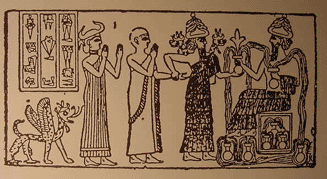 Dumuzi, King Gudea of Lagash, Ningishzida, and Enki Another Greek incarnation of Dumuzi was the Dionysus, the god of wine. Those who shared in the passion of Dionysus were said to go through a rebirth. During the ceremonial worship of Dionysus, a large bearded mask representing the god-man was hung on a wooden pole and, dressed in purple garments and given a crown of ivy. Wine was consumed during the ceremony, of course. Many Greek writers accepted Dionysus as being the same as Osiris, the Egyptian god who was killed by his evil brother Set and then brought back to life by having his pieces reassembled by his wife. Osiris was also called "He who gives birth to men and women a second time". The Greek poet Herodotus stated that the rites of Dionysus were derived from those of Osiris. In Alexandria, 300 B.C., the sage Timotheus fused the two deities together and gave him the name Serapis. 12 When the Romans took Dionysus for their own worship, they called him Bacchus. In Rome, the mysteries of his cult were closely guarded, and he was identified with an ancient god of wine, Liber Pater.13 Many legends connected with Dionysus were also used in the cult of Bacchus. Orpheus, who is depicted as a fisherman and is said to have died a violent death, is said to be a legendary prophet of Dionysus. He was said to have become a Bacchoi, an enlightened disciple who becomes an incarnation of Dionysus.12 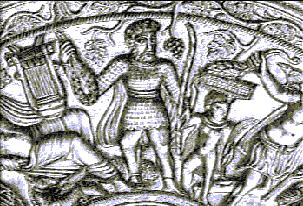 Orpheus holding a net and staff. Wheat and grapes representing bread and wine grow next to him and a fish lies behind his feet.  Plaster cast of an amulet; "Orpheus becomes a Bacchoi", 300 A.D. Seven stars and a crescent moon hang overhead Housed in the museum of Berlin but lost during World War II.12 The worship of Dumuzi evolved into many different forms as it spread throughout Mesopotamia and Europe. The male-only worship of the Persian god Mithras was another god whose holy day was Christmas and marked by the sharing of gifts. By slaying a bull and eating it's flesh and drinking it's blood, Mithras was able to gain immortality to wait an return at the end of time. A common icon of Mithras pictured two torchbearers on either side of him; one holding the torch up to heaven and the other pointing it down to the netherworld.12 On a wind-rocked tree Nine whole nights, With a spear wounded, And to Odin offered Myself to myself; On that tree Of which no one knows From what root it springs." This is comparable to some of the passages in the New Testament:
"The law is not based on faith; on the contrary, 'The man who does these things will live by them.' Christos redeemed us from the curse of the law by becoming a curse for us, for it is written: 'Cursed is everyone who is hung on a tree.'" -Galatians 3:12-13 There are even tales in literature of pagan Vikings feasting with Christian ones in which the Christians made the sign of the cross and the pagans accepted it as the sign of the hammer, which was what they used to bless food, and so respected it as a sign of faith. The Christian theological connection between the Tree of Knowledge and the crucifixion of Jesus is that the self-sacrifice was to atone for the Original Sin that Adam cursed mankind with by eating the forbidden fruit. Because of this, Jesus is often referred to as the Second Adam. The portrait of Christ being crucified on a tree is assumed to be symbolic of the historic Roman execution, which is traditionally believed to have taken place directly over Adam's grave, now located in the Chapel of Adam at the Church of the Holy Sepulchre in Jerusalem. "My brother, your dream is not favorable, don't tell me any more of it! Dumuzi, your dream is not favorable, don't tell me any more of it! The rushes rising up for you, which kept growing around you, are bandits rising against you from their ambush. The single reed shaking its head at you is your mother who bore you, shaking her head for you. The twin reeds of which one is taken away and then the other is you and I -- first one and then the other will be taken away. The tall trees in the forest rising up together over you are the evil men catching you within the walls. That water was poured over your holy coals means the sheepfold will become a house of silence. That the cover of your holy churn was being removed for you means the evil man will bring it inside in his hands. Dumuzi told his sister that he would hide in the grass and asked her not to reveal his hiding place. Two demons from the cities of Adab, Akcak, Uruk, Ur, and Nibru came and caught Geshtinanna, offering her fields of grains and rivers of water for his location, but she refused to tell them. So they left her and bribed Dumuzi's friend, then caught Dumuzi in the ditches of Arali. Once again, Dumuzi appealed to Utu and this time he was changed into a gazelle and escaped. The demons followed him to Kuberish, the house of Old Woman Belili, and then to his sister's holy sheepfold. Geshtinanna appealed to heaven and earth in Dumuzi's behalf. She lacerated her face in public and her buttocks in private, but regardless, the ten demons caught up with him at the sheepfold and destroyed the bolt, the shepherd's stick, and the holy churn (or cream mixer). They killed Dumuzi and the sheepfold became haunted.  Dumuzi attacked by gala demons Dumuzi and Geshtinanna opens with demons allowing Geshtinanna to leave her imprisonment in the netherworld by substituting Dumuzi. The demons fasten Dumuzi in metal stocks and begin sharpening their axes. From bondage Dumuzi cried out to Utu, imploring him to turn him into a sajkal snake so that he could escape. Utu accepted his tears and changed him and Dumuzi slithered out of the stocks and then flew away. Dumuzi went to his sister Geshtinanna's and she told him that demons were out looking for him. Just as she spoke, the demons appeared at her door and demanded that she tell him where Dumuzi was. Dumuzi escaped from the house before the demons broke in and began to torture Geshtinanna to get her to talk. They afflicted her loins with a skin disease and poured tar in her lap, but she said nothing. Unfortunately, the demons once again found Dumuzi in the sheepfold, sharpened their daggers and smashed in his hut. The last line has his sister wandering the streets saying, "My brother, let me take the great misfortune, come, let me..." This suggests that the substitution is cyclical, that Dumuzi's sister took his place for half the year to reflect the changing seasons. 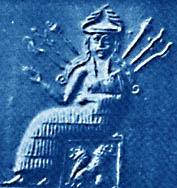 Inanna Statuette Easter falls on the first Sunday after the first full moon after March 20th, the nominal date of the Spring Equinox. The modern method of governing the date of Easter was devised in Alexandria in 325 AD. In Asia Minor the Megalensia festival was celebrated on the three days of the spring equinox by tying an effigy of the god Attis to a sacred pine tree and decorated with flowers.11 The Christian tradition of a sunrise service on Easter is shared by ancient pagans, a practice recorded by the prophet Yechezk-El: Then said he to me, Son of Man, have you seen what the elders of the house of Yisra-El [Israel] do in the dark, every man in his chambers of imagery? For they say, Yahweh doesn't see us; Yahweh has forsaken the land. He said also to me: 'You shall again see yet other great abominations which they do.' Then he brought me to the door of the gate of Yahweh's house which was toward the north; and see, there sat the women weeping for Tammuz [Dumuzi]. Then said he to me, Have you seen this, Son of Man? You shall again see yet greater abominations than these. He brought me into the inner court of Yahweh's house; and see, at the door of the temple of Yahweh, between the porch and the altar, were about twenty five men, with their backs toward the temple of Yahweh, and their faces toward the east; and they were worshipping the sun toward the east. -Ezekial 8:14-16 The weeping for Tammuz was a ritual mourning over Dumuzi's death, equivalent to the grieving on Good Friday. The sun rising in the east represented the rebirth of Dumuzi, just as it today represents the resurrection of Christ. East is actually called east because of it's relation to Easter. Inanna |

